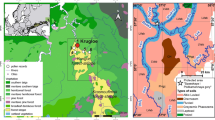Abstract
Urbanization can have a deteriorating effect on the ecology of an area. However, small green areas can have an important value as a refuge for rare and protected species in the urban environment. This study focuses on the black alder forests of the natural-historical park “Izmailovo”. The floral composition of this relict of the original floodplain forests the first time ever is revealed and, - the ecological-floristic and dominant classification of the described phytocenoses is given. Due to the low recreational load, populations of rare and protected plant species of Moscow and Moscow region are better preserved, which makes these phytocoenoses unique in terms of maintaining biodiversity and protecting nature.
Access this chapter
Tax calculation will be finalised at checkout
Purchases are for personal use only
Similar content being viewed by others
References
Polyakova, G.A., Gutnikov, V.A.: Moscow parks: ecology and floristic characteristics, 408 p. Institute of Forest Science, Russian Academy of Sciences. GEOS, Moscow (2000)
Velichko, A.A., Gerasimov, I.P.: Paleogeography of Europe for the last hundred years, 175 p. Science (1982)
Ipatov, V.S.: Description of Phytocenosis, 93 p. St. Petersburg (1998)
Mirkin, B.M., Naumova, L.G., Solomeshch, A.I.: Modern Science on Vegetation, 264 p. Logos, Moscow (2001)
Lenin, V.I.: Diagnoses and Keys of Age-Old Conditions of Forest Plants. Trees and Shrubs: Methodological Developments for Students of Biological Specialties, 102 p. M. Publishing House/Prometheus (1989)
Rabotnov, T.A.: Experimental Phytocenology, 160 p. Izd-vo MGU, Moscow (1987)
Zagornolova, L.B., Bekmansurov, M.V.: Classification of plant communities (typological diversity). In: Biological Diversity of Vegetation Cover of the National Park “Mari Chodra”. Part I, pp. 52–74, Yoshkar-Ola (2003)
Gubanov, I.A., et al.: 429. Alnus glutinosa (L.) Gaerth. - Alder sticky, or black. Illustrated determinant of plants in Central Russia. In 3 volumes. - Moscow: Te-na nauch. ed. KMC, Institute of Technology. issled. - T. 2. Angiosperms (dicotyledons: dioecious). -FROM. 27 (2003)
Gubanov, I.A., et al.: Wild-growing useful plants of the USSR. Otv. Ed. TA Rabotnov. Thought, pp. 90–92 (1976)
Vasilevich, V.I., Shchukina, K.V.: Black-alder forests of the north-west of European Russia. Bot. J. 86(3), 15–26 (2001)
Ellenberg, H., Weber, H.E., Düll, R., Wirth, V., Paulssen, D.: Zeigerwerte von Pflanzen in Mitteleuropa. Scripta Geobotanica 18, 258 (1992)
The determinant of forest types in European Russia - Access mode. http://www.cepl.rssi.ru/bio/forest/index.htm
Bulokhov, A.D., Solomeshch, A.I.: Ecological and floristic classification of forests of the Southern Non-Black Earth Region, p. 359. Publishing House of the Belarusian State University, Bryansk (2003)
Il’inskaya, S.A., Matveeva, A.A., Kazantseva, T.N.: Types of forests. In: Forests of Southern Moscow Region, pp. 54–205. Nauka, Moscow (1985)
Mirkin, B.M., Rosenberg, G.S., Naumova, L.G.: Dictionary of concepts and terms of modern phytocenotology
Samoilov, B.L., Morozova, G.V. (eds.): Red Book of the City of Moscow/Government of Moscow, 2nd ed. Department of Nature Management and Environmental Protection of Moscow, 928 p. Pererab. and add, Moscow (2011)
Rysin, L.P., Abaturov, A.V., Savel’eva, L.I., Melancholn, P.N., Polyakova, G.A., Rysin, S.L.: Dynamics and sustainability of recreational forests. Te-na nauch. ed. KMC (2006). 165 with
Author information
Authors and Affiliations
Corresponding author
Editor information
Editors and Affiliations
Rights and permissions
Copyright information
© 2020 Springer Nature Switzerland AG
About this paper
Cite this paper
Istomina, I.I., Pavlova, M.E., Terekhin, A.A., Meer, T.P. (2020). Relict Floodplain Forests as a Refuge for Rare and Protected Species Within the City. In: Vasenev, V., Dovletyarova, E., Cheng, Z., Valentini, R., Calfapietra, C. (eds) Green Technologies and Infrastructure to Enhance Urban Ecosystem Services. SSC 2018. Springer Geography. Springer, Cham. https://doi.org/10.1007/978-3-030-16091-3_19
Download citation
DOI: https://doi.org/10.1007/978-3-030-16091-3_19
Published:
Publisher Name: Springer, Cham
Print ISBN: 978-3-030-16090-6
Online ISBN: 978-3-030-16091-3
eBook Packages: Earth and Environmental ScienceEarth and Environmental Science (R0)




